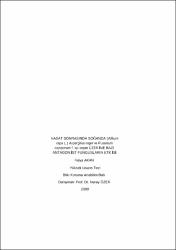| dc.contributor.author | Akan, Fulya | |
| dc.date.accessioned | 2017-04-24T07:48:53Z | |
| dc.date.available | 2017-04-24T07:48:53Z | |
| dc.date.issued | 2009 | |
| dc.identifier.uri | https://hdl.handle.net/20.500.11776/386 | |
| dc.description.abstract | Bu çalısmada yemeklik soğanda (Allium cepa L.) çürümeye neden olan Aspergillus niger van Tieghem ve Fusarium oxysporum Schlechtend.: Fr. f. sp. cepae (Hans) Synder&Hans üzerine bazı antagonist fungusların etkileri belirlenmistir. Trichoderma sp. ’ne ait iki izolat (TRIC3 ve TRIC8) her iki patojenin kontrolü için, Penicillium sp. (PEN15) ve Aspergillus sp. (ASP3)'ne ait birer izolat sırasıyla A. niger ve F. oxysporum f. sp. cepae'nin kontrolü için kullanılmıstır. Denemeler, patojenlerin olusturduğu lezyon çapı ve yara kolonizasyon siddeti gibi parametre ölçümlerine dayalı, antagonistlerin farklı iki konsantrasyonu (106 and 107 konidi ml-1) kullanılarak, yaralanmıs elma meyvesi ve soğan yumrusu üzerinde gerçeklestirilmistir. A. niger antagonist uygulaması yapılmamıs elmalar (Kontrol) üzerinde lezyon olusturmus ve aynı zamanda kontrol elma meyvesi ve soğan yumrularındaki yaraları kolonize etmistir. F. oxysporum f. sp. cepae sadece soğanda açılan yarayı kolonize edebilmis, kontrol elmada herhangi bir lezyon ya da kolonizasyona neden olamamıstır. A. niger üzerine antagonist fungusların etkinliği kullanılan test bitkileri ve ölçülen parametrelere göre farklılık göstermistir. TRIC8 izolatının 107 konidi ml-1 konsantrasyonundaki uygulaması ölçülen tüm parametreler açısından A. niger ve F. oxysporum f. sp. cepae enfeksiyonunu en yüksek oranlarda azaltmıstır. | en_US |
| dc.description.abstract | In this study, the effects of some antagonist fungi on onion (Allium cepa L.) bulb rot caused by Aspergillus niger van Tieghem and Fusarium oxysporum Schlechtend.: Fr. f. sp. cepae (Hans) Synder&Hans were determined. Two isolates (TRIC3 and TRIC8) of Trichoderma sp. were tested for control of both pathogens on onion bulbs. Additionally, one isolate of Penicillium sp. (PEN 15) and Aspergillus sp. (ASP3) were used for control of A. niger and F. oxysporum f. sp. cepae, respectively. Assays were performed on wounded apple fruits and onion bulbs using two different concentrations (106 and 107 conidia ml-1) of antagonists, based on different parameters of measurement such as lesion diameter, wound colonization severity by pathogens. A. niger caused lesions untreated apple fruit with antagonists. The pathogen also colonized the wounds on untreated apple fruit and onion bulb. F. oxysporum f. sp. cepae was able to colonize only the wounds in onion and did not cause any lesion or colonization on untreated apple. The effectiveness of antagonistic fungi on A. niger differed to the test plants and parameters. The isolate TRIC8 at the concentration of 107 conidia ml-1 reduced the infection by A. niger and F. oxysporum f. sp. cepae at the highest rate for all parameters. | en_US |
| dc.language.iso | tur | en_US |
| dc.publisher | Namık Kemal Üniversitesi | en_US |
| dc.rights | info:eu-repo/semantics/openAccess | en_US |
| dc.subject | biyolojik kontrol | en_US |
| dc.subject | soğan (Allium cepa L.) | en_US |
| dc.subject | test yöntemi | en_US |
| dc.subject | yumru çürüklüğü | en_US |
| dc.subject | Aspergillus niger | en_US |
| dc.subject | Fusarium oxysporum f.sp. cepae | en_US |
| dc.subject | biological control | en_US |
| dc.subject | onion (Allium cepa L.) | en_US |
| dc.subject | test method | en_US |
| dc.subject | bulb rot | en_US |
| dc.title | Hasat sonrasında soğanda (Allium cepa l.) Aspergilus niger ve Fusarium oxysporum f. sp. cepae üzerine bazı antagonist fungusların etkisi | en_US |
| dc.title.alternative | The effects of some antagonist fungi on Aspergillus niger and Fusarium oxysporum f. sp. cepae in onion (Allium cepa L.) after harvest | en_US |
| dc.type | masterThesis | en_US |
| dc.department | Enstitüler, Fen Bilimleri Enstitüsü, Bitki Koruma Ana Bilim Dalı | en_US |
| dc.relation.publicationcategory | Tez | en_US |



















